I just got back from spending a week in Barcelona. It’s a great city, the weather was perfect, and the crowds weren’t too bad. A very enjoyable trip all around. As usual, I have a few observations that struck me while there.
Urban Culture
I used to have a team I supervised in Madrid, so I had been to that city many times, but never made it to Barcelona apart from one brief in and out trip. I was eager to compare and contrast the two.
One thing that struck me was an analogy to the Midwest. Spain was once a mighty empire, but became a sort of backwater for quite a while. Madrid was always a sort of provincial capital not as important in world affairs as say London, New York, or Paris. And within Spain, Barcelona is a regional capital, one looking to assert its own cultural identity, such as by emphasizing the Catalan language. Some even want Catalonia to be independent from Spain. I definitely noticed that the Catalonian flag is ubiquitous while you need to look closely to see Spain’s national flag.
This is somewhat similar to the Midwest. Chicago is the provincial capital, and other cities in the region want to assert themselves on the national stage. Of course, we’ve got to be careful about analogies, particularly with foreign countries. No city in the Midwest is a rival to Chicago in the way Barcelona fancies itself a rival to Madrid. And Chicago itself is in some ways a second city like Barcelona. But I’ll try to tease out some provocations anyway.
The thing I found most interesting was actually a lack of distinct regional culture in Barcelona vs. Madrid. To me, Barcelona just seemed generically “European”. Sure, you knew where you were, but it was a similar experience to many other European cities. But when you go to Madrid, it is very clear you are in Spain, in a Spanish city. There’s the weight of all the history, the culture, and above all a notable lack of English speakers. Barcelona is much more cosmopolitan. In pretty much every establishment I visited, someone spoke good English, which is definitely not the case in Madrid.
Possibly the language matter is due to Barcelona’s embrace of Catalan. I don’t think it is unreasonable to expect that any Westerner should know at least a few words in Spanish and French, but clearly almost nobody is going to learn Catalan. Hence, if you want to embrace that language, you must be willing to engage in English with foreigners.
Consider also the artists. The artists that are the backbone of the Prado collection – Goya, Velazquez, El Greco – are ones that immediately conjure up Spain in the mind. But Barcelona’s native sons Picasso and Miró were modern artists whose names bring to mind place like Paris and MoMA above all. So too with architecture, as Barcelona has clearly more embraced the modern than Madrid. There are even more modern furniture outlets there.
If I were to draw a surmise from this, it would be that: when a regional provincial capital tries to assert its identity, the result is a sort of generic cosmopolitanism.
If you look at the Midwest, you see this in action. It is Chicago (like Madrid), not the other regional cities, that has the most unique identity. And most of the efforts smaller cities are putting into asserting themselves is through self-consciously embracing a sort of generic cosmopolitan style, by implementing standard urban items like sports stadiums, starchitect buildings, and transit systems that are as much about signaling as they are about actual results.
Beyond this, it seemed to me that Madrid was much more a business center. Barcelona didn’t give off that vibe at all. I’m not even sure what its main industries are. Also, Madrid seemed to have much more recent construction than Barcelona. Tons of new apartment blocks and office towers had sprung up there. And there was an orgy of freeway construction (including several underground tunnels) and transit system expansions, including many new tram lines that reach even suburban office parks. I didn’t notice nearly as much of that in Barcelona.
Density and Transportation
As with Madrid, Barcelona is an exceptionally dense city by the standards of the west. The core is about 40-50,000 per square mile, greater than any US core other than Manhattan. But as is often the case in Europe, this is in the form of 6-8 story buildings, not skyscrapers, refuting the notion that height equates to density. There are almost no vacant lots or surface parking anywhere in the city, though the interior of blocks often features courtyards or lower rise structures that make them look hollow. Here’s a view of the city taken from one of the bell towers of Sagrada Familia:
Naturally this enables a robust transit system, and Barcelona has an excellent, high frequency subway network that, as with many European cities but unlike in the US, is a mesh-like structure that serves most of the city, enabling you to get almost anywhere with a simple transfer. It is not a core-centric radial system. Headways are excellent. I never waited even one minute for a train and something like eight times in a row the train pulled into the station just as we arrived at the platform. There is also an extensive and well-patronized bus system with a modern rolling stock.
The streets themselves are largely a grid outside of the gothic-era core. Avinguda Diagonal cuts through the grid at an angle like Market St. in San Francisco. Many of the streets are very wide. I often hear people in places like Indianapolis bemoan their wide streets. I take exactly the opposite view. In most cases, the street ROW is actually too narrow. There are many Barcelona streets wider than the right of way of Washington St., Indy’s widest. The big difference is that in the US we give most of the ROW to cars, with only tiny sidewalks. In Barcelona and throughout Europe they accommodate plenty of cars, but give large amounts of the street to general sidewalks, wide medians, landscaping, and such, creating a much better pedestrian experience. Barcelona also has a plethora of one way streets, which seems not to have hurt it.
Speaking of pedestrians, there is a high density of them throughout the city. I did see some bike lanes, but most of these appeared to be carved out of previously pedestrian space, not auto traffic. There is also a bike share program, which accounted for about 80% of all the bikes I actually saw on the street. Barcelona’s biking culture far lags that of many US cities. The preferred mode of transit is instead the scooter, which is ubiquitous. It appears to be legal to park them on the sidewalk.
Unlike in the US, all of the sidewalks I saw were either flagstones or modular pavers. It also appears that they run most of their utilities under the sidewalk, not under the street pavement. I saw very few projects tearing up streets, but several on the sidewalk, though generally not disruptive. It’s a great solution. To access utilities, you simply pull up the pavers, shovel away the sand, and get at it. Replace the sand and pavers when you are done. Looks better than concrete and functions better than cobblestones. Also, they use granite curbs and wheelchair ramps. Very nice.
Architecture
Barcelona is known for its architecture, particular that of the so-called modernista movement (related to Art Nouveau). The best known exponent of this, and certainly the most original, was Antoni GaudÃ. His works are heavily influenced by nature and come across as sort of a fairy tale setting.
His most famous work is the Sagrada Familia church.
Here’s a closer look at the bell towers. These are actually mosaics.
This project was started in the 19th century and is still under construction. It is estimated to be completed in 2030, making it like a modern day equivalent of the gothic cathedral projects.
Another well known Gaudà building is Casa Milà , also known as La Pedrera.
Facade detail showing the intricate ironwork railings:
Chimneys (aka Imperial stormtroopers) on the roof:
One last example is Park Güell:
Gaudà was fortunate to work at a time when he had access to modern construction techniques such as steel frame construction, but also to craftsman who could create his unique works.
When you think of all this old architecture that even today enchants visitors, it makes you think. There was a great era of architecture from say 1850-1914 in Europe and from 1875 to the end of the art deco era in the early 1930’s in the United States. It was actually a great era in many other ways. The French called it the Belle Époque. And it wasn’t just the modernista and Art Nouveau in Europe. Most of the core civic structures of the Midwest were built in this era as well. Virtually none were built after them.
I think of Indianapolis, where the Indiana State House, the Soldiers and Sailors Monument, Union Station, the movie palaces, and the Indiana World War Memorial (started 1926) all date to this era. Has there been a truly great building constructed in Indianapolis since the Scottish Rite Cathedral in 1929? A similar story could be told in most places. For much of the US, this is the era that defined the architecture that creates the civic sacred space. Europe obviously has a longer architectural history, but this era saw most of the last of the entries. If many of these were simply vernacular pieces, at least they were good ones, especially compared to what came later.
The mid-century period and beyond produced plenty of architecture that is critically acclaimed, but for the public at large even the best of these buildings inspire more respect than affection. And unlike previous eras, the vast bulk of the copies of the masterworks were severely lacking. Many of them blight our cities to this very day.
What went wrong? In the Great War and the Great Depression something in the human spirit was grievously wounded.
But today we see signs of recovery. While I have my quibbles with starchitecture, there’s little doubt many of these structures are beloved by the public in the way a Miesian monolith never will be. These architects remembered that aesthetics is the answer to the great question of “What is Beauty?”, a question too seldom asked in the modern world. While it is too early to judge, perhaps we are the start of another age of good design. I don’t think it is any accident that like the previous one, today’s design age takes place against a backdrop of economic revolution and all that comes with it. Will the Great Recession kill the baby in its crib? We’ll see.
Here are a few more shots from Barcelona. First, Casa Batlló by GaudÃ
The Mercat de Santa Caterina
The Museu Nacional d’Art de Catalunya
The Palau de Musica Catalana
Dining and Entertainment
I won’t say much on this, other than that Barcelona is a famously hard partying town. Alas, I’m past the age for such things, but I did notice quite a crowd of people still carousing on the streets at 6:30am as we were in the cab on the way to the airport to leave. Reputedly there are over 20,000 bars in Barcelona.
The food is also quite good. I didn’t go hungry, that’s for sure. Very heavy on seafood, as one might expect being so close to the coast.
I’ll leave you with one of those strangely named restaurants that always gives one pause in a foreign country.



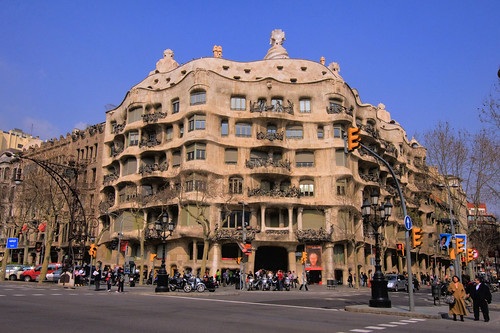

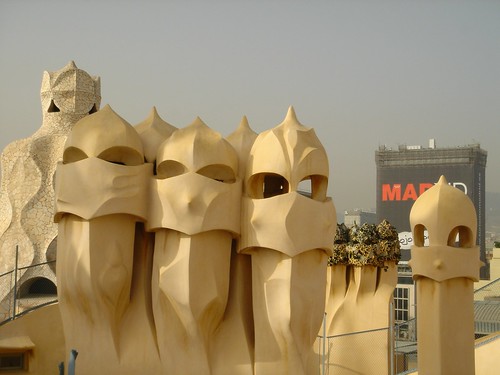
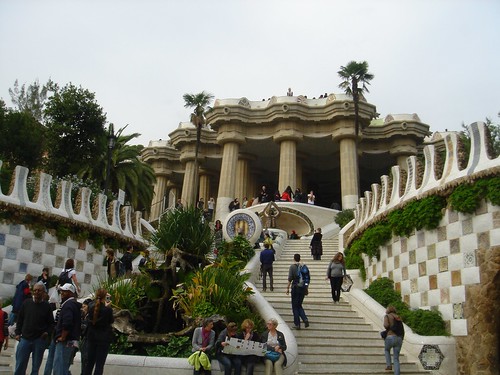
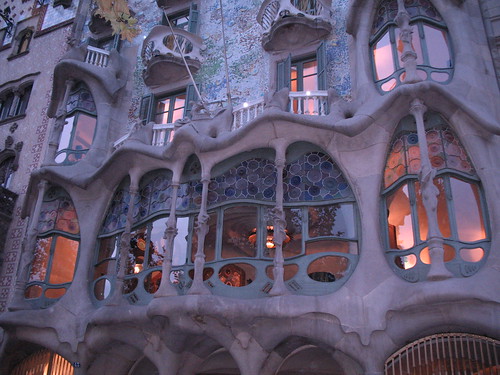

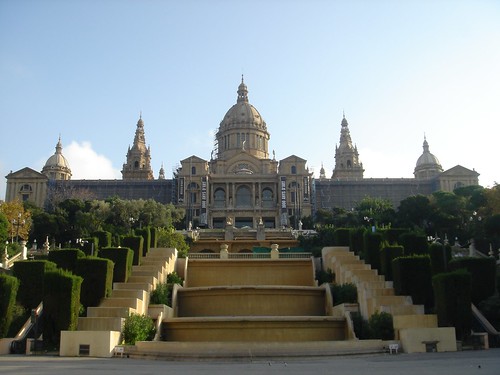
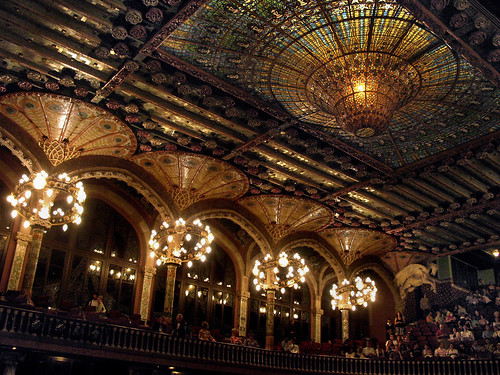
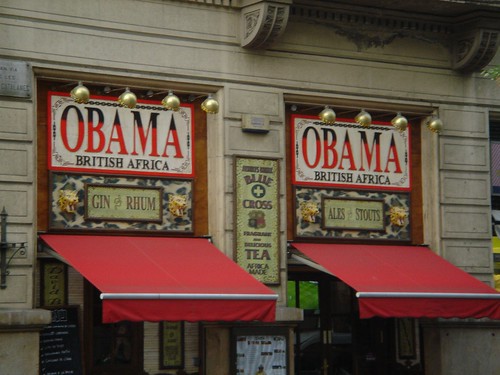
thanks for a good post – showing the american in europe 🙂
thanks also for your insights on various aspects of barcelona.
however – as an architect student myselves, i really think you should update yourself on contemporary architecture in barcelona in front of your next visit there.
please learn about the “torre agbar” of jean nouvel, the architects enric batlle & joan roig and also zaha hadid has something to offer you. please browse the groups on flickr and archdaily related to barcelona.
sincerely,
Architects: Enric Batlle & Joan Roig, arquitectos
Aaron, nice post. Barcelona’s cosmopolitanism is less of a language thing, and more of a coastal thing. Historically, and still today, ports bring in ideas, people, other cultures. Barcelona is, and always has been, a Mediterranean city, like Marseille (which shares a similar relationship with Paris, as Barcelona does with Madrid), or Genoa, Napoli, Athens. And remember, for most of Barcelona’s history, it has probably been significantly harder to get to Madrid than to the other Mediterranean cities, so we shouldn’t expect it to come across as “Spanish”. Mediterranean culture is unique though. It covers a wide area, with multiple nationalities, which I guess is why it comes across as a little “European generic”, but if you think about it as “Mediterranean” you can see points of distinction.
MR Renn
Welcome back!Thank you for posting about your trip.Its good to read an evenhanded and objective account of a European city. Too often in America the political left thinks that Europe is paridise and has no problems.And the political right thinks that Europe is some sort of socialistic hellhole.
I wish that the American media would take a more honest look at European cities and realise that they do have problems.But I also wish that the media would examine how these cities are dealing with their problems.
We could learn a lot about which solutions work and which don’t.The whole,simplistic, Europe as paridise/hell narritive is used way too often in the media nowdays.
I myself have always wondered about how some of the old industrial cities have dealt with the issue of de -industrialisation.
I hope that you can write more about how different cities in the world are dealing with these kind of issues.
Read http://www.jsonline.com/news/opinion/69419357.html today and thought of you — it is an article comparing a Spanish city to a Midwestern city. Came to your blog and found THIS post today comparing a Spanish city to a Midwestern city. Pow! Not exactly the same type of comparison but still…
Based on the one picture of ordinary city buildings, I’d say that yes, they look similar to buildings in Nice. As far as I remember Milan, they’re similar to it, too. On the other hand, many of them look exactly like New York brownstones.
Aaron. Yes, all through my last trip through Europe this year I was marvelling at that hopeful period you mention. It’s remarkable that so much of that Art Nouveau spirit survived World War I to flourish as Deco. I wrote a bit about its Austrian manifestation, the “style of youth,” here:
http://www.humantransit.org/2009/08/vienna-and-the-style-of-youth.html
The relative worldliness of Catalonia compared to Madrid reminded me much of the Dutch as compared to the Germans or French. More open to the sea, and so more ready to allow difference to flow over them, and yet very clear about who they are.
I’m not sure which is the motivation and which is the response, but the wide sidewalks of Barcelona and other European cities accommodate residents’ love of being outside and not just for dining. They also accommodate natives who chide Americans for their aversion to walking from place to place. Along with fresh food, walking may be a reason that obesity is less of a problem there.
Aaron,
After Franco’s demise, the powers-that-be in Barcelona made a conscious effort to brand the city as an international hub for industrial design. This has become one of the key industries there, and the design aspect has spurred growth in the tourist sector.
Here’s a link to an article by Guy Julier from the Leeds School of Architecture titled “Urban Designscapes and the Production of Aesthetic Consent”.
http://usj.sagepub.com/cgi/content/abstract/42/5-6/869
Thanks for the comments everyone.
Harald, I did see Torre Agbar and a few others. Some of the better contemporary examples are off the beaten path for a tourist. On a future visit I’d love to see them. I was already over-photoed on this piece, but searching flickr is a good idea. I did note that Barcelona has embraced modernism, and the buildings you cite are good examples of its contemporary manifestation. There is certainly plenty to see and do in Barcelona, that’s for sure.
Jarret, I remember that article now. Thanks for sharing the link.
Aaron,
Read your response to Harald and you are correct that it’s impossible to appreciate the richness of Barcelona’s history, architecture and culture in one short visit. Given all those qualities, we’ve found that it’s still a city with an unpretentious charm that has long since been superseded by smugness in other destinations. To experience that firsthand you must replace the tourist schedule with a sense of living there, even for a short time. If you haven’t tried it, next time rent an apartment (pick the neighborhood as well as the property) and go with the local flow.
great report!
I was interested in your comment about Barcelona’s metro system being a “mesh-like structure that serves most of the city.” Do you think that American cities, and especially those now looking at new light rail systems, can learn anything from this layout? Most of the systems I’ve seen have been a hub-and-spoke system centered on downtown.
In a place like my hometown of St. Louis, I wonder how much sense this makes with downtown continuing to decline in importance with respect to jobs relative to the rest of the region. Are we building transportation systems based on a 19th/early 20th century idea of the American city? Namely workers commuting into a “downtown” core where most of the jobs are located? With jobs continuing to migrate out of downtown despite a highway system centered on it, how much sense does it make to invest in fixed infrastructure centered on this particular part of the metro area?
In short, are we too fixated on an antiquated, 19th century view of the American city, which looking back may actually have been an anomaly with regard to commuting patterns and job concentration? And is the future one of overall more density, but with jobs and destinations spread out more evenly, more like the Barcelona model? Considering the resources invested in these systems, it seems rather important to have a clear idea of which direction our cities are heading. Any thoughts from the author or other commenters would be welcome.
I’m posting a little late, but just wanted to say I loved this. I spent 7 days in Barcelona in 2005 and you are right about many things – including the partying! Thanks for featuring Sagrada Familia. In my opinion it is a more impressive church than even St. Peter’s in Rome.
I’m glad someone brought up the port city point, because that’s what was going through my mind when I read of your comparisons of the two cities. Another interesting comparison would be Barcelona-Rotterdam and/or Rotterdam to other cities in the Netherlands.
Also I just wanted to say that the Art Deco buildings in Chicago are some of my favorite architecture there. I believe it’s the Carson Pirie Scott building, with the amazing arch over the door??
michelle, thanks for chiming in!
Terranaut, probably a “web” model, which is a mesh with non-parallel radials to/from the center, is the appropriate conceptual design for most US cities.
This is appropriate as their CBDs hold jobs (i.e. actual number of jobs is steady or grows more slowly than the outlying districts), but lose relative share of jobs to the suburbs/exurbs. Thus, a web: multiple crosstown linkages across the radials enable commutes that do not involve the central node.
Alas, such a distributed system has a price: the whole metro would have to be far more walkable or bikable, so that people could make 5-10 minute walks at each end of their commute. This is anathema in a nation where walks to the front door from parking is usually measured in feet.
Aargh. Grammar check on post 15: “…walks to the front door from parking ARE usually measured in feet.”
In Moscow and Singapore, the metro is configured for high speed and high station spacing, with bus rides at both ends of the trip. I don’t know about Moscow, but Singapore is definitely not walkable: if you look at its street network on Google Maps, it will look like a typical suburban cul-de-sac-ridden map, rather than like a dense city grid.
It’s not how Barcelona’s subway is configured – for a start, the average interstation in Barcelona is less than half that in Singapore and Moscow. And it’s telling that the Singaporean/Muscovite way of building subways evolved in an environment of strict controls on car ownership, both in the Soviet Union and in modern Singapore. But it’s one way of building subways.
It wouldn’t matter if Singapore had a more walkable built form since the tropical climate makes walking more than a short distance outdoors unpleasant. It’s hot and humid almost every day, with frequent rain.
The tropical climate in Singapore promotes mall-oriented development. But malls can still be laid in a walkable manner – for example, they’re fairly walkable in Singapore’s CBD and on Orchard Road (they’re also walkable in the central parts of Shanghai). In Singapore it’s common for young people to walk around from mall to mall – sometimes out in the hot air.
In Tel Aviv, which is just as hot in the summer, this is common as well, in the more walkable parts of town. Some streets – e.g. Sheinkin, Basel, Dizengoff – have even managed to preserve walkable old urbanism.